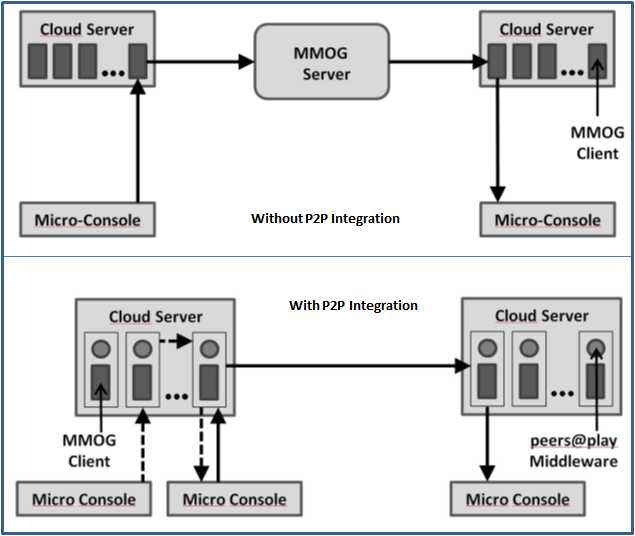Gaming in the Cloud
By Danny Cao | December 04, 2012 2:30 pm

Source: Verizon
Breaking news: Scientists have recently discovered a new type of cloud! However, these scientists aren’t your ordinary meteorologists, they’re computer scientists; and this is no ordinary cloud. It’s not going to rain on you, or run rampant across the Atlantic before bringing devastation to the coast, and it definitely won’t create pretty wispy patterns in the sky; no, this is a virtual “Cloud,” a new advanced technological discovery with just as much potential as a hurricane, and it spells promise for the future of gaming.
In terms of high-tech talk, Cloud computing is now one of the most hotly anticipated developments in the online world. In its simplest definition, Cloud computing refers primarily to the applications and services provided to users via the Internet. Many people go about their daily online lives not realizing that they are a part of the “Cloud,” the virtual mass data storage center that contains everything you would ever need for your online endeavors.
Cloud computing works in a similar way to drawing electricity from an electrical outlet; by plugging into the Cloud, you can access whatever applications, files, or data you have stored in the Cloud anytime, anywhere, and from any device. This allows for an infinitely larger storage space than can be contained on a single hard drive. Essentially the Cloud can be thought of as a large virtual warehouse from which data can be sent and pulled.
Cloud computing has found useful application in online marketing services such as Amazon and Ebay as well as information databases such as Google and its vast assortment of services. Some common examples include Dropbox, the Google Apps Marketplace, Netflix, Xerox, and Apple iCloud, a Cloud application built by Apple designed for the sole purpose of multi-use data storage.
Now scientists are interested in seeing how Cloud computing be used for online gaming. Cloud gaming has recently been proposed as an alternative to traditional video game distribution. With this approach, the entire game is stored, run and rendered on a remote server. Player input is forwarded to a server via the Internet and the game’s output is returned as a video stream. This means that even on an old desktop or laptop computer with a poor graphics card for 3D rendering, a user can still send all of their actions and game data to the Cloud where the data is processed in high quality with little-to-no lag and then sent back to the user’s computer as a video. It would be similar to watching a high definition Youtube video, except, instead of just viewing a video, the user is playing a game.
Unfortunately, this technology still needs tweaking. Sending data through a remote Cloud server and then reading the return data could add a delay; such lags are a plague to gameplay; that said, a closer proximity to the Cloud server can make such delay minimal. Currently, Massive Multiplayer Online Games (MMOGs), a large portion of the PC gaming industry, suffer from additional server to client lag, which can be harmful to the delay-sensitive nature of MMOGs. Many first-person shooters and real-time Role-Playing-Games require precision input and suffer immensely from even the slightest lag.
As a result, current research is being conducted on the effectiveness of using peer-to-peer (P2P) techniques to migrate game server functionality directly onto Cloud servers. P2P involves data communication between two entities without the need of a dedicated translation server to pass information between the two. It’s kind of like cutting out the middle man. Normally, a player’s computer which is tied to a game client must send information through a dedicated server that translates the information into the Cloud and then out to the game server. By moving the game server directly into the Cloud, this eliminates the need for extraneous data transfer. Without the need for processing information through a separate dedicated server, the entire server-to-client link in the Cloud thus effectively cuts down on additional delay. So far, results have been promising and further inquiry could provide insight into the next generation of online gaming.

There already exist many Cloud gaming service providers. In recent news Sony, creator of the well-known PlayStation and other electronics, purchased one of the leading Cloud gaming services, Gaikai for $380 million. Sony stated that it would use Gaikai’s revolutionary Cloud gaming technology and servers to establish a new Cloud service. By combining Gaikai’s technological strength with Sony’s game platform knowledge and experience, Sony hopes to take its Cloud entertainment services to the next level.
Overall, the future of gaming looks bright with new technological advances into the field of Cloud computing. Many existing Cloud gaming service providers, such as Gaikai, have seen positive reviews in their initial trials and the gaming industry can expect to see an increase in this type of service in the near future. Furthermore, the notion of gaming in the Cloud portrays just one of the many unharnessed potentials of Cloud computing technology. With a little bit of innovation, the forecast for tomorrow may just look Cloudy with a chance of progress!
Further Reading
Could Mobile Cloud Gaming Overtake Next-Gen Consoles?
Windows 8 cloud gaming service Agawi’s promising future on the Xbox 720
Can Cloud-Based Gaming Topple Consoles?
References
Suselbeck, R.; Schiele, G.; Becker, C.; , “Peer-to-peer support for low-latency Massively Multiplayer Online Games in the Cloud,” Network and Systems Support for Games (NetGames), 2009 8th Annual Workshop on , vol., no., pp.1-2, 23-24 Nov. 2009
doi: 10.1109/NETGAMES.2009.5446229
Michael Armbrust, Armando Fox, Rean Griffith, Anthony D. Joseph, Randy Katz, Andy Konwinski, Gunho Lee, David Patterson, Ariel Rabkin, Ion Stoica, and Matei Zaharia. 2010. A view of cloud computing. Commun. ACM 53, 4 (April 2010), 50-58. DOI=10.1145/1721654.1721672 http://doi.acm.org/10.1145/1721654.1721672
Catgorized Under: Technology
For more popular science writing, return from whence you came.